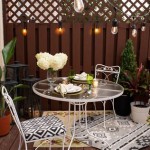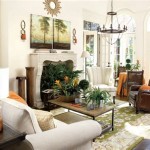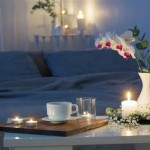How To Decorate A Rectangular Dining Table
The rectangular dining table is a staple in many homes, offering a versatile surface for both everyday meals and special gatherings. Its shape provides ample space for diners while offering a natural focal point within the dining area. Effectively decorating a rectangular dining table enhances its functionality and elevates the overall aesthetic of the space. Several key considerations and techniques contribute to a beautifully styled table, transforming it from a mere utility into a captivating centerpiece.
Understanding the Dimensions and Purpose
Before commencing the decoration process, it is essential to understand the dimensions of the dining table. Measuring the length and width provides the necessary information to select appropriate accessories. Consider the table’s size in relation to the room itself. A large rectangular table might dominate a smaller dining area if not properly balanced with other furnishings. Conversely, a smaller table in a larger space may appear undersized and require strategic decoration to achieve visual harmony. Furthermore, evaluate the table's primary function. Is it used primarily for everyday dining, formal dinners, or a combination of both? This will influence the choice of materials, accessories, and overall design approach.
Choosing a Foundation: Tablecloths and Runners
The foundation of a well-decorated rectangular dining table often begins with a tablecloth or table runner. A tablecloth offers complete coverage and can instantly transform the ambiance of the room. Consider the fabric, color, and pattern of the tablecloth. Linen and cotton provide a classic and versatile look, while silk or velvet add a touch of luxury for special occasions. Solid-colored tablecloths offer a clean, modern aesthetic, while patterned options introduce visual interest and personality. Choose a tablecloth length appropriate for the occasion. A more formal setting often utilizes a tablecloth that drapes closer to the floor, while a casual setting may feature a tablecloth that reaches just below the tabletop. Alternatively, a table runner presents a more contemporary and streamlined look. These long, narrow pieces can highlight the center of the table and can be layered over a bare tabletop or a neutral-colored tablecloth. Experiment with contrasting colors, textures, and patterns to create visual depth and interest. Consider the material of the runner, opting for materials that complement the overall décor scheme.
Centerpiece Selection: Balancing Aesthetics and Functionality
The centerpiece acts as the focal point of the rectangular dining table, drawing the eye and setting the tone for the setting. The selection of a centerpiece requires careful consideration of both aesthetic appeal and functionality. The centerpiece should not obstruct the view or hinder conversation among diners. A low, elongated arrangement generally works best for rectangular tables, allowing guests to easily see each other across the table. Floral arrangements remain a classic choice. Select flowers that complement the color scheme and reflect the season. Consider using seasonal fruits, vegetables, or other natural elements as part of the arrangement. Candles provide both illumination and visual interest. Incorporate various heights and sizes to create depth and create the appropriate ambiance. Consider the scent of the candles and opt for unscented options for dining. Decorative bowls or trays offer a versatile platform for showcasing various items. Fill them with seasonal ornaments, decorative objects, or even edible items like fruit. Consider the proportions of the centerpiece. Avoid overcrowding the tabletop. The centerpiece should complement the table’s size and shape, not overwhelm it.
Place Settings: Creating a Cohesive and Functional Arrangement
Place settings are an essential aspect of dining table decoration, combining practicality and visual appeal. Cohesive place settings showcase the food while establishing a sense of order and elegance. When arranging place settings, several elements must be considered. Dinnerware should be selected based on the style and occasion. For formal dining, consider using matching plates, bowls, and serving pieces. For a more casual approach, mix and match different patterns and colors for a more eclectic look. Flatware, including forks, knives, and spoons, should be arranged neatly on the table, following established etiquette guidelines. Glassware for water, wine, and other beverages should be chosen to complement the dinnerware and the overall aesthetic. Napkins, whether made of fabric or paper, add a finishing touch to the place settings. They can be placed at the left of the fork, on top of the plate, or within a napkin ring. Consider incorporating placemats to protect the table surface and add visual interest. Choose placemats that complement the tablecloth or table runner. Proper spacing between place settings ensures each diner has sufficient room to eat comfortably.
Accessorizing and Layering for Depth
After establishing the foundation and place settings, accessories may add final touches. Consider layering different elements to add greater visual depth and complexity to the table setting. Decorative objects, such as small vases, figurines, or sculptures, can be placed strategically to fill empty spaces but must not overwhelm the table. Charger plates, placed beneath the dinner plates, can add a touch of elegance and color. Consider incorporating decorative napkin rings to elevate the look of the place settings further. Consider lighting when accessorizing. Use lamps, overhead lighting, or candles to enhance the ambiance of the dining area. Ensure all accessories complement each other and create a cohesive visual story. Avoid cluttering the table with too many elements. The goal is to create a balanced and aesthetically pleasing arrangement that enhances the dining experience, not detracts from it. The selection of colors and patterns is critical. Ensure all colors and patterns work together well to enhance the overall aesthetic of the dining room.
Adapting to Different Occasions
The beauty of a rectangular dining table is its adaptability. Decorations can be modified to suit various occasions, from casual family meals to formal celebrations. For everyday dining, opt for a simpler approach with a neutral tablecloth, minimalist centerpiece, and straightforward place settings. For formal dinner parties, elevate the table with a luxurious tablecloth, elegant centerpiece, and carefully arranged place settings. Consider incorporating decorative elements that reflect the theme of the occasion, such as seasonal decorations for holidays or themed elements for special events. Using creative place cards to assign seating arrangements can add a personalized touch. Experiment with different color palettes and textures to reflect the ambiance of the event. The key is to adapt the approach to the event, ensuring the decorations complement the overall ambiance and theme.

Sorella Rectangle Dining Table Room Design Decor

Diy Archives Homesthetics Dining Room Small Table Centerpieces Cozy

30 Dining Table Decor Ideas For Any Style Of Home Hunker

101 Dining Room Examples With A Rectangle Table Photos

Rectangular Dining Room Table Centerpiece Ideas Dimasummit Homeslice

Dining Room Table Decor Ideas How To Decorate Your
:strip_icc()/kitchen-table-ideas-17-becca-interiors-southampton-2ae87107ad6840779a77daf523d10323.jpeg?strip=all)
23 Kitchen Table Décor Ideas To Try In Your Home

51 Rectangle Dining Tables To Refresh Your Space

Unique Rectangular Dining Table Designs Designcafe

23 Unique Dining Room Table Designs Decoist
Related Posts







